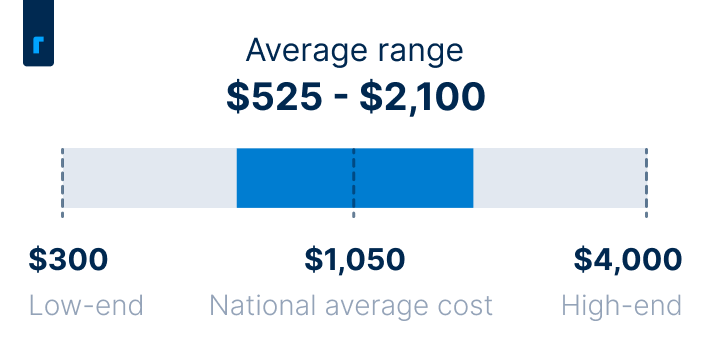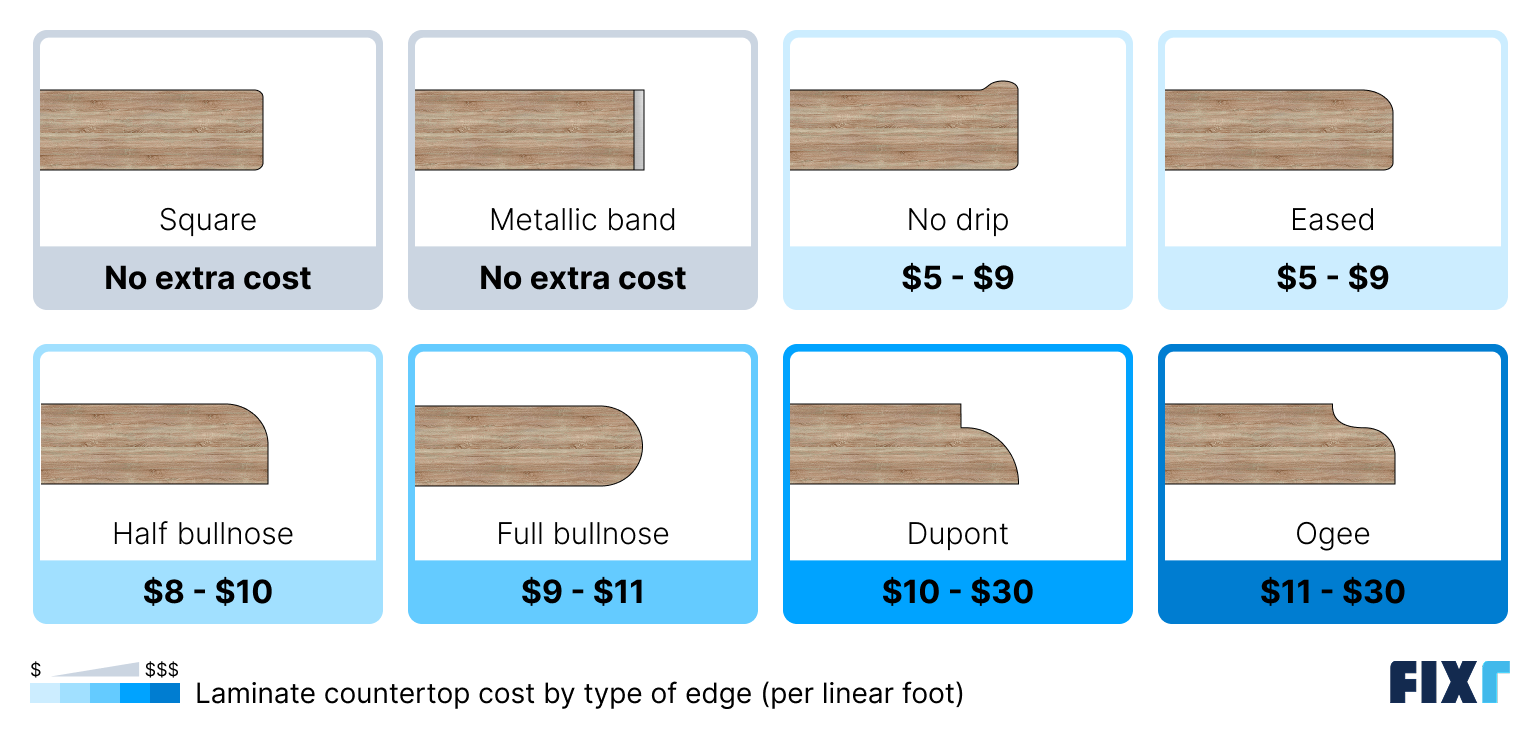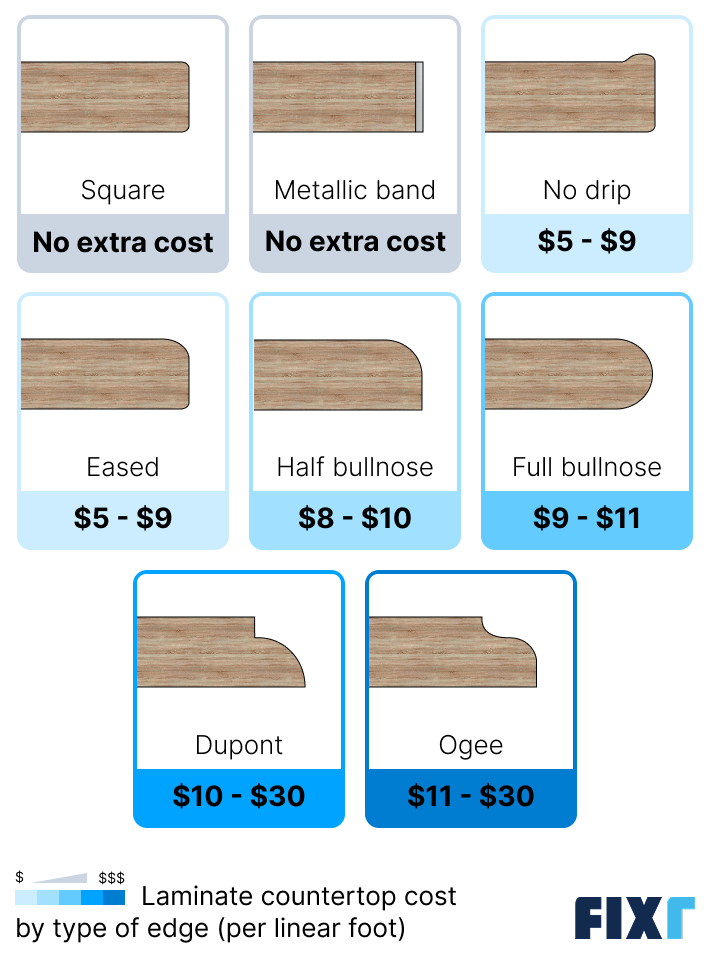Updated: September 2, 2025
Written by Dan Simms
Nieves is a home remodeling editor at Fixr.com with special interest in landscaping, pest control, painting, installation, and repair projects. She brings her work ethic, creativity, and love for teamwork into everything she does, including working with writers and designers at Fixr.com to develop useful and comprehensive guides for homeowners.
Learn moreReviewed by Nieves Martinez
Laminate countertops are a low-cost way to update your kitchen and freshen up the space. They’re made from several layers of plastic laminated together to form a durable surface, which the manufacturer then attaches to medium-density fiberboard (MDF). The countertops come in many colors and styles and can mimic the look of granite and other stones, although the appearance is of a much lower quality.
The total cost to install laminate countertops can range from $525 to $2,100, with a national average of $1,050. This is for the average kitchen countertop size of 35 sq. ft. Several factors influence the final overall cost, including the specific type of laminate, the countertop’s edge style, and its thickness. Countertop installation costs are also determined by the project's complexity, with more custom work driving up the total cost.
Cost of Laminate Countertops


Laminate Countertop Cost per Square Foot
Laminate countertops cost an average of $30 per square foot, but prices can range from $15 up to $60 per square foot, depending on the quality of the material, the color and finish options, and the complexity of the installation. You may have other costs to consider, though, such as the edging for a more luxurious appearance, multiple cutouts for sinks, faucets, and soap dispensers, and a matching or built-in backsplash.
Countertop Size (Sq. Ft.) | Cost Range |
20 | $300 – $1,200 |
30 | $450 – $1,800 |
35 | $525 – $2,100 |
40 | $600 – $2,400 |
50 | $750 – $3,000 |
Laminate Countertop Cost Factors
The average cost of laminate countertops varies so much because there are multiple factors at play that affect your per-square-foot and total costs. The type and quality of the laminate you choose are the most significant factors, but customization options and edge options can also affect your pricing.
Laminate Countertop Prices by Type
Laminate is a material made up of multiple sheets of paper coated in a resin and heated and pressurized together to form a durable surface. That surface then goes over a substrate, which is usually MDF or plywood. The quality of the resins and the substrate used during manufacturing play a major role in your laminate countertop cost, with higher-quality materials costing more but also lasting longer and standing up better to the constant wear and tear they’ll see.
There are three primary types of laminate countertops.
Standard laminate has no special finish and has the lowest durability, but it’s also the most affordable.
Antimicrobial laminate helps keep your countertops clean and may help avoid exposure to bacteria. This add-on does drive up your laminate countertop price per square foot.
The third type is a high-durability finish, which maximizes countertop lifespan and resilience to wear. It has the thickest layers of protective laminate and high-quality resin, and it often uses a plywood substrate rather than MDF for better durability. High-durability laminate, sometimes referred to as Formica despite that being a brand name, is the most expensive type. However, the added strength allows for undermount sinks and adds the most value to your kitchen.
Laminate Type | Average Cost per Square Foot |
Standard (horizontal grade/high pressure) | $10 - $18 |
Antimicrobial finish | $15 - $30 |
High-durability finish | $20 - $50 |
Custom vs. Prefab
Customization is one of the biggest cost factors when it comes to laminate countertops. Standard, pre-fabricated pieces are widely available at home improvement stores or through remodelers, and because they’re mass-produced, they tend to be the most affordable option. For simple kitchen layouts, prefab laminate countertops can keep costs down without sacrificing style.
However, homeowners with unique layouts often need custom pieces for a proper fit. Ordering custom laminate countertops usually means paying 25% to 100% more due to added labor, special orders, and the tendency to select higher-end finishes. While more expensive, customization ensures precise measurements and a seamless look that prefab options can’t always achieve.
Luxury Laminate Countertops
Laminate counters have long been considered low-cost and low-quality, and while that still can be true, there are more premium options out there. Formica, which is a brand name but also commonly refers to high-quality laminate over plywood rather than MDF, is a great example. It can be textured to mimic other materials better, can often support undermount sinks due to the more rigid plywood substrate, has fewer visible seams, and lasts longer due to a more durable finish. Luxury laminate countertops can cost twice as much as standard laminate, though, reaching up to $50 per square foot, or $1,750 for the average kitchen.
Laminate Countertop Edge Options
Standard laminate countertops usually come with a simple square edge, but there are a few affordable variations. Homeowners can choose a half- or full-bullnose edge with rounded corners, a beveled edge with a diagonal cut, a no-drip edge that helps contain spills, or even metallic banding for contrast. These options are generally budget-friendly and widely available.
Luxury laminate counters expand the selection with more intricate designs. Eased edges offer a softer version of the bullnose, while Ogee and Dupont edges create elegant curves and angles that mimic the look of stone. These premium edges give laminate a high-end finish that can elevate the entire kitchen design.
It’s worth noting that square and band edging are often included at no extra cost, while specialty edges add to the price based on the linear feet of countertop required. Choosing the right edge style comes down to balancing budget with the level of design detail you want in your space.


Edge | Average Cost per Linear Foot |
Square | No cost |
Metallic band | No cost |
No-drip | $5 - $9 |
Eased | $5 - $9 |
Full bullnose | $9 - $11 |
Half bullnose | $8 - $10 |
Ogee | $11 - $30 |
Dupont | $10 - $30 |
Substrate
Laminate countertops include layers of laminated paper and plastic resin installed over a substrate to give the countertop heft, thickness, and durability. The most affordable laminate countertops use MDF as a substrate, which is much weaker and less durable than plywood, and it expands rapidly when it gets wet, which means your countertops will get ruined if you wear through the protective layer or let spills sit on the surface. The durability is lower with an MDF substrate, but you’ll pay between $10 and $18 per square foot for the countertops.
A plywood substrate is significantly more durable and boasts more strength, so you can fit it with undermount sinks, which you can’t do with MDF. Plywood will still expand with exposure to moisture, although not as much as MDF, so you don’t have to be as worried about spills or wearing through the surface as you would with the more affordable option. Only high-end laminate countertops use this substrate, so expect your costs to climb to between $20 and $50 per square foot.
Substrate | Cost Range per Square Foot |
MDF | $10 - $18 |
Plywood | $20 - $50 |
Labor Cost to Install Laminate Countertops
On average, you can expect to pay between $30 and $40 per hour for labor, or between $10 and $30 per square foot, depending on the complexity of the installation. For an average 35 sq. ft. kitchen, labor costs will typically account for $350 to $1,050 of the total project cost. Labor costs can sit lower if you’re just having your pro install prefab countertops and you handle removing the old materials yourself.
In addition to the basic installation costs, you may have other costs included as well. If you need your contractor to remove and haul away your old countertop, expect to add $50 to $300 for the service. You’ll pay closer to the lower end of that range for lightweight materials like old laminate and closer to the higher end for heavier granite or marble.
Laminate Countertops Pros and Cons
The biggest upside to installing laminate countertops is the low upfront cost. Even luxury laminate costs a quarter of what you’d pay for high-end marble or granite. Laminate is also fairly low-maintenance because it does not need to be sealed and doesn’t require special cleaners. Modern laminates can be reasonably durable, resisting scratches and scuffs, and it is also possible to get antimicrobial surfaces for a safer kitchen.
On the other hand, laminate is not very eco-friendly, as it is made of plastic and cannot be recycled. The manufacturing process of laminate emits a lot of VOCs, and the material continues to off-gas after installation. While luxury laminate is relatively durable and long-lasting with fewer seams, most standard laminate eventually begins to delaminate, or peel, around the edges. Although laminates can be made to mimic the look of granite or other natural stone, they lack the high-end appearance and feel of a luxury material.
Pros
- + Very affordable
- + High-end can be durable
- + Easy to work with
- + Lightweight
- + Easy to clean
- + Lots of customization
- + Resists stains
Cons
- - Not sustainabl
- - Can look cheap
- - Prone to delamination
- - Shorter lifespan than alternatives
- - Prone to burns and scratches
- - Not repairable
- - Resale value
When choosing your kitchen countertop material, it’s important to balance budget with durability. While more expensive options like granite or quartz offer long-term value, the right choice ultimately depends on your specific needs and lifestyle.
Price of Laminate Countertops vs Granite
Laminate countertops average $15 to $60 per square foot, while granite countertops average $40 to $150 per square foot. The choice between the two often comes down to budget and long-term value. While granite is more expensive, it can easily last two to three times as long or more, and it stands up better to wear, stains, and burns from hot pans and baking sheets. Granite also provides a high-end aesthetic and greater resale value for your home, and requires less maintenance overall. For busy kitchens or maximum value add, granite is always going to be the better option, despite costing more. However, laminate's wide range of styles and lower cost can make it the ideal choice for homeowners looking for an affordable kitchen update.
DIY vs. Hiring a Pro
Laminate is a relatively easy countertop material to work with, as it’s lightweight and doesn’t require special tools to cut or install like more common stone countertops would. DIYing the installation will save you an average of between $350 and $1,050 on labor for a standard-size kitchen, so it’s a solid option for handy homeowners and those on a tight budget.
However, you’ll usually see better results and have a lower risk of mistakes if you have a professional install your countertops, and you won’t risk having to pay for damages to the materials from maneuvering them into your space or installing them. A pro will also have more experience measuring for your countertops, which can lead to a smoother installation and a better fit. While you will save money doing the work yourself, it’s usually worth hiring a professional.
How to Save Money on Your Laminate Countertop Project
While DIYing can save you money, there are some other things you can do to keep costs down if you’re not comfortable doing the installation yourself, or you just want to leave the installation to a pro for the best results possible.
Go with prefab laminate countertops: Custom laminate countertops can double your material costs, so if possible, stick with prefab to save.
Choose the countertop quality carefully: Standard laminate countertops will keep your costs as low as possible, so choose this option if you’re on a tight budget. However, keep in mind that you’ll get more long-term value from luxury laminate, so the higher upfront cost could be worth it.
Keep the edge options simple: Most laminate countertop manufacturers offer squared edges and banded edges at no additional cost, so choose one of these to avoid additional charges.
Have a professional measure for you: Hiring a pro can avoid measuring mistakes that lead to wasted materials and reorders, so although expert installation will drive up costs, it could end up being worth it.
Remove your old countertops yourself: You can save between $50 and $300 if you demolish and haul away your old countertops yourself. Just be sure to wear proper safety equipment and coordinate carefully with your installer to ensure you aren’t without a countertop for days or weeks.
Consider refinishing your laminate countertops instead: If you have laminate countertops with a plywood substrate already installed, you might be able to repurpose the plywood and have a pro remove the old laminate and replace it to save on material costs.
Minimize cutouts: Cutouts for sinks, faucets, soap dispensers, and water dispensers can all drive up installation costs, especially if you’re working with pre-fabricated laminate countertops. Simplify your layout, if possible, to save some money on labor.
Get at least three quotes: Finally, get at least three estimates for the installation to compare based on cost and quality to find the best value. Avoid companies that come in unusually high or low compared to the others.
Additional Considerations and Costs
To avoid surprises, keep costs down, and get the most out of your laminate countertops over time, here are some additional considerations and possible cost add-ons you can expect.
Warranty. Most laminate countertops today come with a 1-year warranty from the manufacturer. Always check to find out what that covers so you can be prepared to make a claim if something unexpected happens.
Trivet use. Laminate countertops are some of the most prone to heat burns, so never place hot pans, pots, or baking sheets directly on your counters. Always use a trivet or hot pad to avoid scorching and permanent burn marks.
Cleaning. Laminate is easy to clean with a soft cloth, dish soap, and water. Always dry the countertop thoroughly and wipe up spills as soon as they are noticed to avoid water pooling in the seams and causing permanent damage.
Cutouts. Cutouts for sinks, soap dispensers, and other penetrations through your countertop can add $100 to $200 to your total. Minimizing the number of cutouts can keep costs down and also help reduce the areas where water can seep into the substrate and cause permanent water damage.
Permits. If you’re just replacing your countertops, you likely won’t need permits, but if the cost to replace laminate countertops is part of a bigger kitchen remodel total, permits can add hundreds to your total. Speak with your remodeling pro to see how much permits will cost in your area.
Adding a backsplash. It is very common to install a new backsplash at the same time as the countertop to give the entire kitchen a makeover at once. The average cost of a new backsplash is between $500 and $1,500, although prices range much more widely depending on the materials you choose.
Sink installation. The sink cutout is included in what you pay for the countertop, but you have added costs for installing the sink after the counter is in. The average cost of sink installation is between $300 and $500, although more affordable top-mount sinks will bring costs lower.
FAQs
For a standard-size kitchen, you’ll pay between $350 and $1,050 in labor to install laminate countertops. The cost per square foot depends on the complexity of your kitchen layout, the quality of the laminate countertops you purchase, and whether or not you have custom laminate countertops built or need your pro to cut prefab countertops to size while they’re on-site.
Yes, laminate countertops will almost always be cheaper than granite. Laminate countertops are human-made using affordable materials like paper, resin, and either MDF or plywood, while granite is a naturally occurring material that takes more effort to source, cut, shape, and install. Granite countertops cost an average of $90 per square foot, which is three times as much as the $30 per square foot you’d pay for laminate.
Laminate countertops cost an average of $30 per square foot, and for a standard kitchen with 35 square feet of countertops, you’re looking at an average total of $1,050 The most budget-friendly laminate countertops could bring that total down to just $525 for a standard kitchen, while luxury laminate countertops can push that total to $2,100.
There are a few important downsides to consider before installing laminate countertops, the most important of which is durability. Laminate, and especially standard-grade laminate, is the least durable countertop material. It’s sensitive to heat and can burn from exposure to hot pans or baking sheets, it’s more prone to scratches and abrasions than most other countertop materials, and it can swell and deteriorate if water reaches the substrate, which can ruin your countertops. Additionally, laminate can mimic other materials, but standard laminate very much looks like a budget material.
The terms “laminate” and “Formica” have been used interchangeably for years, but Formica is a brand name of laminate countertops. Specifically, Formica specializes in luxury laminate countertops, which have many layers of protective, high-quality resin, as well as a more durable plywood substrate, in most cases. Formica countertops cost up to $60 per square foot, which is twice as expensive as standard laminate countertops.
